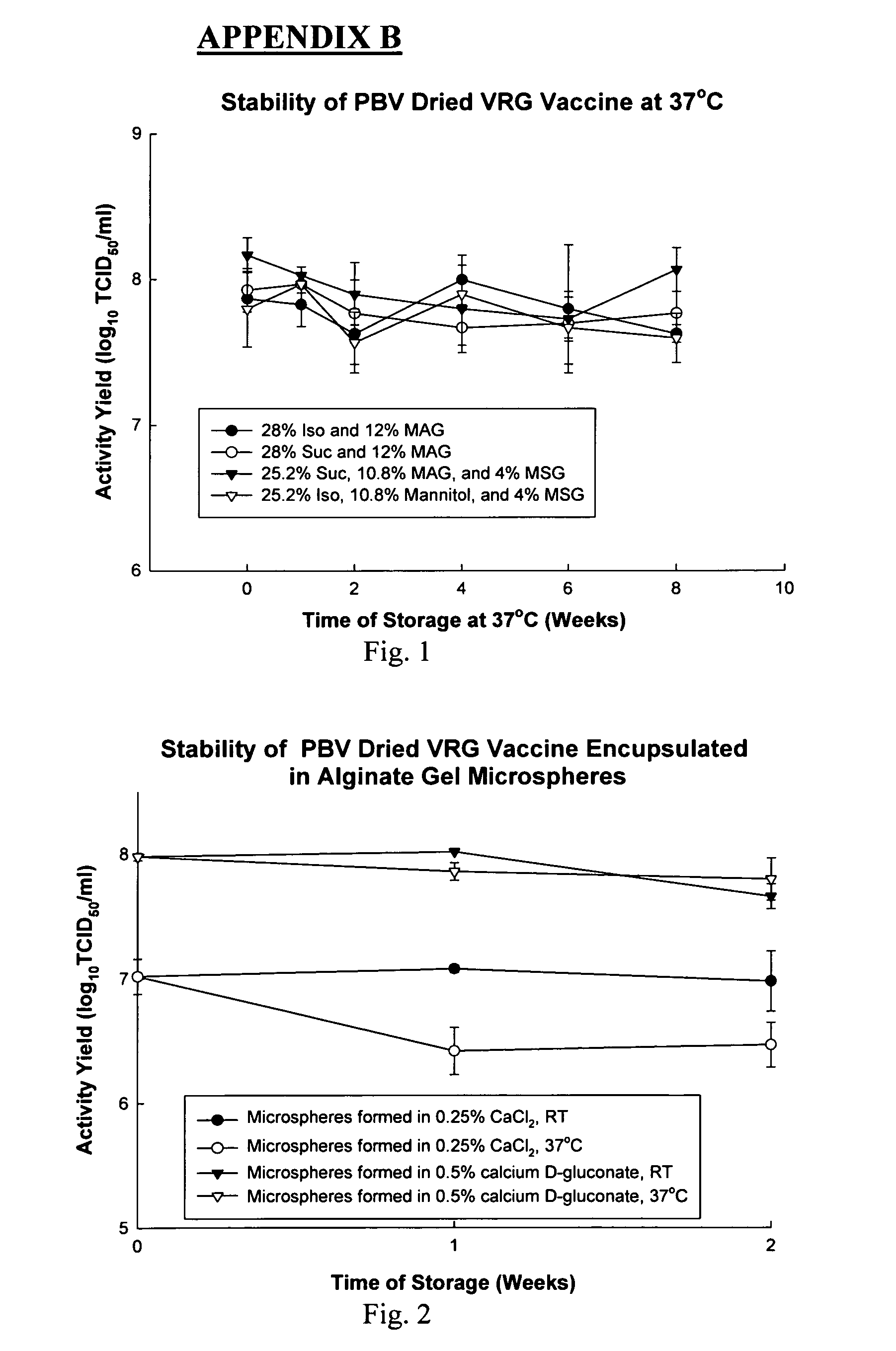Stability Drying
- Summary
- Abstract
- Description
- Claims
- Application Information
AI Technical Summary
Benefits of technology
Problems solved by technology
Method used
Image
Examples
example 1
Example of Stability Drying
[0026]It is well known that most of freeze-dried vaccines are not stable at ambient temperatures. For example, we had recently reported that freeze-dried (F-D) YF-Vax 17D strain of Yellow fever virus (lot UF057AA, Sanofi Pasteur Inc.) and F-D MVA vaccine (ACAM 3000, lot 460301 DA) lose more than 1 log in activity yield after 4 months of storage at 37° C. To better stabilize the same vaccines we performed reformulation that included 20 hours stability drying at 45° C. No decrease in vaccine activity was observed after reformulation and subsequent storage for more than 4 months at 37° C. The vaccines were preserved using our PBV technology reported earlier (PCT Patent Application WO051 1 7962A). To perform PBV stabilization we reconstituted each vial containing freeze-dried vaccines with a preservation solution comprising 28% Isomalt and 12% Methylglucoside (MAG.).
example 2
Preservation of Lactobacillus GG (LGG) Encapsulated in Alginate Gel
[0027]LGG is a well known probiotic bacteria that has been used as an additive to baby food (“Nutramigen-2”) to protect infants from colonization of the intestinal epithelium with pathological bacteria. LGG fermentation was performed inside a 2 L BioFlo fermentor in MRS broth +0.05% cysteine at 37° C. The culture was centrifuged, the supernatant was decanted and pellet was re-suspended 1:1 with a Preservation Solution (0.7% of alginate, 0.7% of high amylase starch, 20% of isomalt and of 10% methylglucoside) to obtain a Preservation Mixture (PM). In this experiment, to form the gel particles, we had used a conventional procedure for preparation of alginate gel microspheres:
[0028]The preservation mixture was sprayed in a bath solution containing 2% CaCl2 and protective sugar derivatives: 10% of isomalt and of 5% methylglucoside. The bacteria in the gel particles were preserved using two PBV drying processes. The stabil...
example 3
Stability of Lm Vaccines Formulated by PBV
[0033]We has examined the stability of a recombinant Listeria monocytogenes (Lm) vaccine constructed by Cerus Corp, and dried using our PBV technology including 20 hours stability drying at 50° C. The viability of the preserved bacteria was evaluated by plating them on BHI agar. The results below (Table 3.1) showed that the vitrified Lm was relatively stable.
TABLE 3.1Stability of PBV-preserved rLm vaccine at 37° C.After stability drying at 50° C.CFU / plateStability (%)Before drying 326 ± 10100%After drying177 ± 754%(100%)20 days at 37° C.154 ± 847%(87%)2 months at 37° C.158 ± 848%(89%)350 days at 37° 117 ± 1636%(66%)
Stability of Lm Vaccine Formulated for Oral Use.
[0034]We also examined the stability of Lm vaccines encapsulated in alginate microspheres and dried by PBV, designed for oral delivery. To encapsulate LMV bacteria in alginate gel microspheres, we used our crosslinking method (cryo-encapsulation) comprising following steps:[0035]a) S...
PUM
| Property | Measurement | Unit |
|---|---|---|
| Temperature | aaaaa | aaaaa |
| Temperature | aaaaa | aaaaa |
| Temperature | aaaaa | aaaaa |
Abstract
Description
Claims
Application Information
 Login to View More
Login to View More - R&D
- Intellectual Property
- Life Sciences
- Materials
- Tech Scout
- Unparalleled Data Quality
- Higher Quality Content
- 60% Fewer Hallucinations
Browse by: Latest US Patents, China's latest patents, Technical Efficacy Thesaurus, Application Domain, Technology Topic, Popular Technical Reports.
© 2025 PatSnap. All rights reserved.Legal|Privacy policy|Modern Slavery Act Transparency Statement|Sitemap|About US| Contact US: help@patsnap.com

